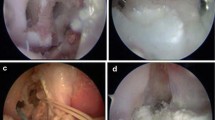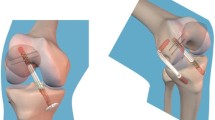Abstract
An "apparent" lengthening of the ligament implant, which causes an increase in knee laxity after the reconstruction of the anterior cruciate ligament (ACL) may be due to either slippage of the implant from under the fixation devices, or tunnel migration (due to bone resorption). These two mechanisms are related to the initial ligament placement, implant tensioning, and fixation modes. This cadaveric study simulates, in a controlled experimental situation, the postoperative lengthening of artificial ACL implants, and seeks to quantify the consequent increase in joint laxity. Eight cadaveric right knees, in which the Leeds-Keio artificial ligament was implanted, were tested in a specially constructed apparatus, which allowed the knee joint six degrees of freedom. In each of the tested joints the laxity was measured under several test conditions for two final fixation modes of the implant. The difference between the fixation modes was the application (as in mode B) or not (as in mode A), of a posteriorly directed force of 50 N on the tibia, at the moment of final fixation of the ligament. In both cases a tensile load of 50 N was maintained along the implant. All measurements were taken at flexion angles of 20° and 90° and with controlled implant lengthening of up to 3 mm in 0.5-mm increments. After implantation, adopting fixation mode B resulted in the knee exhibiting an anterior laxity considerably less than the original physiological laxity, compared with that measured after using fixation mode A. Thus at 20° of knee flexion, under an anterior load of 100 N applied on the tibia, adopting fixation mode B, the joint laxity was 2.8 mm smaller than the natural laxity, whereas, for fixation mode A, it was 1.4 mm larger. At 90° of knee flexion, the situation was similar, but with smaller differences. However, the situation was overturned as the implant length was increased. Thus, at 20° of knee flexion, when the implant was lengthened in a range of 1–2 mm, the laxity observed with fixation mode B was similar to that recorded when the ACL was intact, whereas the laxity observed with fixation mode A was about 3–4 mm greater. Similar data were observed at 90° of knee flexion. It appears that fixing the implant finally by applying a tensile load on it while simultaneously pushing the tibia posteriorly could be an effective measure against the possible return of joint laxity.
Similar content being viewed by others
Author information
Authors and Affiliations
Additional information
Received: September 12, 2000 / Accepted: January 18, 2001
About this article
Cite this article
Cuppone, M., Seedhom, B. Effect of implant lengthening and mode of fixation on knee laxity after ACL reconstruction with an artificial ligament: a cadaveric study. J Orthop Sci 6, 253–261 (2001). https://doi.org/10.1007/s007760100044
Issue Date:
DOI: https://doi.org/10.1007/s007760100044




